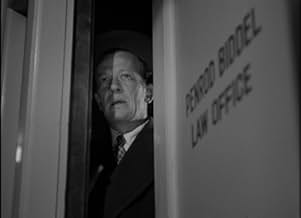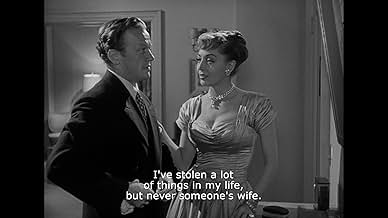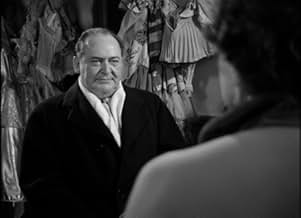IMDb-BEWERTUNG
6,7/10
1756
IHRE BEWERTUNG
Füge eine Handlung in deiner Sprache hinzuJohnny Kelly, who plans on resigning from the police force and leaving his wife the next day, has a very eventful last night on duty.Johnny Kelly, who plans on resigning from the police force and leaving his wife the next day, has a very eventful last night on duty.Johnny Kelly, who plans on resigning from the police force and leaving his wife the next day, has a very eventful last night on duty.
Tom Poston
- Detective
- (as Thomas Poston)
Roy Barcroft
- Mechanical Man Attraction Hawker
- (Synchronisation)
- (Nicht genannt)
Helen Gibson
- Woman
- (Nicht genannt)
Empfohlene Bewertungen
Contrary to the croonings of Liza Minnelli and Frank Sinatra, The City That Never Sleeps is not New York, New York but Chicago, Illinois. At least it is in John H. Auer's 1953 movie of that name, sort of a noir-inflected Grand Hotel or Dinner At Eight, that opens and closes with floodlit vistas of the wedding-cake Wrigley Building. Several characters' lives intersect in an urban crime drama that even offers a touch of the fanciful.
Gig Young, at the center, plays a cop who's dissatisfied with his job and with his marriage (his wife, Paula Raymond, makes more money than he does). Off hours, he hangs around a strip club called The Silver Frolics on Wabash Avenue to see, both on stage and backstage, headliner Mala Powers. That relationship is a rocky as his marriage, and she's as unhappy with her lot as he with his (`Whaddaya want me to do? Crawl into a deep freeze?' she taunts him during yet another breakup). Then Young heads to the precinct for the graveyard shift, riding in a prowl car with a new partner he's never met before (Chill Wills, who also plays the unseen `Voice of the City').
During Young's nocturnal tour he meets up again and again with the various players in the plot. There's rich, crooked lawyer Edward Arnold, who blackmails him into burglarizing some incriminating papers; his two-timing wife, Marie Windsor; former magician turned criminal William Talman; his own brother (Ron Hagerthy) who's now Talman's apprentice; his pop (Otto Hulett), a police veteran; and a `mechanical man' (Gregg Warren) who entertains passersby in the Silver Frolics' window.
Some of the ties among the characters are up front, others furtive, to be doled out as the plots thicken. By the end (Poverty Row having learned the lessons MGM taught a couple of decades earlier in the titles cited above), there's tragedy and heartache, reappraisals and reconciliations. There's even a character who vanishes as mysteriously as he materialized a whiff of the supernatural which curiously fails to leave any influence on the way the stories unfold.
The City That Never Sleeps shows the right breadth for a big, urban story from Arnold's moderne penthouse to Young's middle-class flat to the raffish alleys running off Wabash Avenue. Director of photography John Russell (later to film Psycho) helps Auer out with some crafty touches (a telephone dial glowing from a flashlight shone upon it comes to mind). It's not a haunting movie, but it's a satisfying one a title that did Republic Pictures proud.
Gig Young, at the center, plays a cop who's dissatisfied with his job and with his marriage (his wife, Paula Raymond, makes more money than he does). Off hours, he hangs around a strip club called The Silver Frolics on Wabash Avenue to see, both on stage and backstage, headliner Mala Powers. That relationship is a rocky as his marriage, and she's as unhappy with her lot as he with his (`Whaddaya want me to do? Crawl into a deep freeze?' she taunts him during yet another breakup). Then Young heads to the precinct for the graveyard shift, riding in a prowl car with a new partner he's never met before (Chill Wills, who also plays the unseen `Voice of the City').
During Young's nocturnal tour he meets up again and again with the various players in the plot. There's rich, crooked lawyer Edward Arnold, who blackmails him into burglarizing some incriminating papers; his two-timing wife, Marie Windsor; former magician turned criminal William Talman; his own brother (Ron Hagerthy) who's now Talman's apprentice; his pop (Otto Hulett), a police veteran; and a `mechanical man' (Gregg Warren) who entertains passersby in the Silver Frolics' window.
Some of the ties among the characters are up front, others furtive, to be doled out as the plots thicken. By the end (Poverty Row having learned the lessons MGM taught a couple of decades earlier in the titles cited above), there's tragedy and heartache, reappraisals and reconciliations. There's even a character who vanishes as mysteriously as he materialized a whiff of the supernatural which curiously fails to leave any influence on the way the stories unfold.
The City That Never Sleeps shows the right breadth for a big, urban story from Arnold's moderne penthouse to Young's middle-class flat to the raffish alleys running off Wabash Avenue. Director of photography John Russell (later to film Psycho) helps Auer out with some crafty touches (a telephone dial glowing from a flashlight shone upon it comes to mind). It's not a haunting movie, but it's a satisfying one a title that did Republic Pictures proud.
If you like your mysteries on the strange side, this movie is the one. I keep wondering how they filmed it without any people on the streets. Stock footage to bolster an obviously low budget helps somewhat, but this movie depicts Chicago in the middle of the night, and the only car on the street is the police car occupied by our hero. But this was 1953, so it was a different world at 3:00 a.m. There is a little of "The Asphalt Jungle" in this one--including the crooked lawyer, a pretty woman too evil for comfort, a safe to steal something from and the usual payment at the end. Then there is the twist -- the "ghost" influence -- who is in the middle of the evening's events, and who also narrates. Plus there's a guy portraying a store window mechanical man. Like I said, this is a strange one, but worth a curious look.
A 1953 Republic gem and a great noir find. This sort of small black and white drama was actually what finished off Republic as TV shows took up this sort of storyline and style, and the studio didn't adapt. Cop Gig Young and burlesque floozie Mala Powers go adulterous and the realism of the noir photography created on actual Chicago streets allow the viewer to be completely absorbed into their cheap backstreet world. This is such an interesting film, and the low budget actually works in its favour......like Monogram's startling DECOY of 1947. Chill Wills appears as a very special and strange character and I won't spoil who he is at all. A very clever and ultimately quite emotional film from a fascinating period in American Cop-dom: 1953...as LA CONFIDENTIAL proved for that city. Find this and relish it, and thank the crummy world of Republic for making it. As a bonus for all us noir-ees, the sensational Marie Windsor is here as well, by the narrowest of welcome margins.
This film set in Chicago in 1952 starts ponderously with a voice-over of 'the voice of the city', strangely that of actor Chill Wills (whose voice is more that of a cowpoke or a ranch hand, thus highly unsuitable for this purpose), who then appears in the crime story as a ghostly police sergeant representing the spirit of the city. Really, we could have done without those affectations, and Wills's acting attempts to be mysterious are worse. However, setting all that aside, the rest of the film is a pretty straightforward crime drama which is very good. Gig Young plays a disillusioned policeman vacillating between leaving and staying with his wife and quitting and keeping his job. One wants to kick him so that he stops dithering, but the story requires him to be like that. There are some strong performances: Mala Powers is good as a wild love interest of Young's, Edward Arnold is suave and persuasive as a bent criminal lawyer, Marie Windsor as usual is svelte and corrupt, and William Talman is very effective as a bonkers criminal who wants to shoot everybody, and nearly does. It's all good entertainment, if you look the other way when the pontificating is going on. One needs to take it with a pinch of paprika (the director, John Auer, was Hungarian).
...is but one of the many elements in this quirky film that makes it SO enjoyable. The plot is complex, but still masterfully laid out, the dialogue is clean and effective, and the imaginative direction, lighting, cinematography and editing clearly place "City" in the ranks of minor classics.
In fact, you are rarely aware that this was a low-budget Republic Studios pic. There's one scene near the end...the standard "calling all cars" scene in the police station, which could have been shot with a single guy at a microphone with a bare wall behind him; instead, we see a bee-hive of activity, with several radio cops reflected in a magical labyrinth of glass panes, with shadowy figures passing through the hallway in back of them. It's seemingly insignificant details such as this that keep "City" bristling with intense visuals and character interplay from beginning to end (yeah, the scene with William Talman breaking into Edward Arnold's office at night could have been edited down to about half its length, and the continually recurring stock footage of the police car's POV while racing past a bunch of 1940's parked cars is pretty comical).
Having a heavyweight actor like Arnold in a pivotal role lends acting "gravitas"; William Talman, an actor I've never really cared for, is superb---subtle, cunning, and ultimately maniacal. The confusion between John Kelly Sr. and Jr. as the tension builds is but one of the masterful plot devices, and the subplot of the Mechanical Man (Wally Cassell) and his dreams of an idyllic life with his lady love amidst the wonders of nature is positively brilliant, as is his change of heart and willingness to sacrifice himself for a noble cause. Cassell's physical skill is as impressive as the emotional sensitivity he brings to the role* And how about mother-in-law's offstage nagging of Gig Young? I found it subtly creepy, almost like mother's voice in PSYCHO.
On top of it all, we have the Chill Wills character; you must decide for yourself if it helps or harms the film; I took it as just another off-beat element in this imaginative story of a single night in Chicago. Who knows?--maybe the whole thing was a bad dream from which Gig Young wakes up at the end.
Only Mala Powers disappoints in her role; she was rather miscast as the tough, world-weary dame, though her more sensitive scenes are fine.
* NOTE - The December 22nd, 1960 episode of TV's June Allyson Show was entitled "SILENT PANIC", and featured HARPO MARX as a deaf-mute who works at Christmastime as a Mechanical Man in a department store window; he also happens to be the only eyewitness to a murder on the street. Sound familiar? Unfortunately, the hour-long show fails miserably to live up to its fascinating premise. But I wonder how many other films, radio shows, stories, etc have used this novel plot device over the years.
In fact, you are rarely aware that this was a low-budget Republic Studios pic. There's one scene near the end...the standard "calling all cars" scene in the police station, which could have been shot with a single guy at a microphone with a bare wall behind him; instead, we see a bee-hive of activity, with several radio cops reflected in a magical labyrinth of glass panes, with shadowy figures passing through the hallway in back of them. It's seemingly insignificant details such as this that keep "City" bristling with intense visuals and character interplay from beginning to end (yeah, the scene with William Talman breaking into Edward Arnold's office at night could have been edited down to about half its length, and the continually recurring stock footage of the police car's POV while racing past a bunch of 1940's parked cars is pretty comical).
Having a heavyweight actor like Arnold in a pivotal role lends acting "gravitas"; William Talman, an actor I've never really cared for, is superb---subtle, cunning, and ultimately maniacal. The confusion between John Kelly Sr. and Jr. as the tension builds is but one of the masterful plot devices, and the subplot of the Mechanical Man (Wally Cassell) and his dreams of an idyllic life with his lady love amidst the wonders of nature is positively brilliant, as is his change of heart and willingness to sacrifice himself for a noble cause. Cassell's physical skill is as impressive as the emotional sensitivity he brings to the role* And how about mother-in-law's offstage nagging of Gig Young? I found it subtly creepy, almost like mother's voice in PSYCHO.
On top of it all, we have the Chill Wills character; you must decide for yourself if it helps or harms the film; I took it as just another off-beat element in this imaginative story of a single night in Chicago. Who knows?--maybe the whole thing was a bad dream from which Gig Young wakes up at the end.
Only Mala Powers disappoints in her role; she was rather miscast as the tough, world-weary dame, though her more sensitive scenes are fine.
* NOTE - The December 22nd, 1960 episode of TV's June Allyson Show was entitled "SILENT PANIC", and featured HARPO MARX as a deaf-mute who works at Christmastime as a Mechanical Man in a department store window; he also happens to be the only eyewitness to a murder on the street. Sound familiar? Unfortunately, the hour-long show fails miserably to live up to its fascinating premise. But I wonder how many other films, radio shows, stories, etc have used this novel plot device over the years.
Wusstest du schon
- WissenswertesFirst credited feature film for actor-comedian Tom Poston.
- PatzerStuntman Dale Van Sickel is clearly seen instead of actor William Talman in the shot where Hayes Stewart jumps over the skylight during the rooftop chase.
- Zitate
Sally 'Angel Face' Connors: When I first came to this town I was gonna be - oh, there were a lot of things I was gonna do. Become famous. But Chicago's the big melting pot, and I got melted, but good.
- Crazy CreditsThis motion picture is respectfully dedicated to the police and police departments of America - a brave army of men and women who form our first line of defense in preserving our sacred principles of personal liberty and justice. We gratefully acknowledge the valuable assistance given by the City of Chicago and its police and Police Department, whose cooperation made this picture possible.
- VerbindungenReferenced in Ôsaka no yado (1954)
Top-Auswahl
Melde dich zum Bewerten an und greife auf die Watchlist für personalisierte Empfehlungen zu.
Details
- Laufzeit
- 1 Std. 30 Min.(90 min)
- Farbe
- Seitenverhältnis
- 1.37 : 1
Zu dieser Seite beitragen
Bearbeitung vorschlagen oder fehlenden Inhalt hinzufügen




































